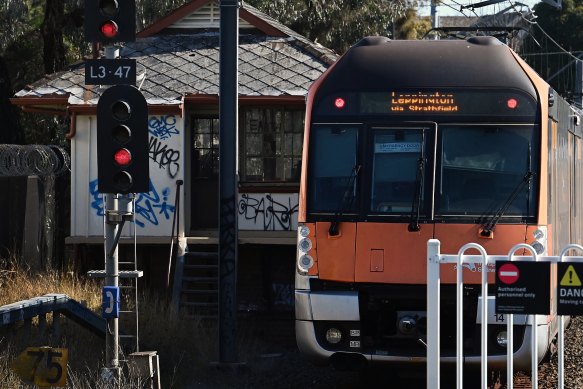- Exclusive
- Politics
- NSW
- Public transport
Sydney Trains running red lights put commuters at risk
By Max Maddison
Trains running red lights on Sydney’s rail network have put commuters at risk of collision eight times over the past two years, new data reveals.
Known as signal passed at danger (SPAD) incidents, the increase in potentially dangerous scenarios is captured in data obtained under freedom of information laws that also shows the total number of events of varying severity increased by 32 per cent to 177 in the two years to 2023–24.

There has been an increase in reportable incidents involving Sydney Trains.Credit: Kate Geraghty
While the majority of SPAD incidents – which can be the result of driver error or mechanical failure – pose a minuscule danger to passengers, trains overrunning signals have caused serious accidents, including the Beresfield rail disaster in 1997.
The data, obtained by Liberal MP Matt Cross, comes during the second stage of Transport Minister Jo Haylen’s near-$132 million Rail Repair Plan, designed to reduce defects and incidents across the network.
The T1 North Shore & Western Line was the most affected, with 181 incidents since 2021–22, followed by the T4 Eastern Suburbs & Illawarra and T2 Inner West & Leppington Line with 58 and 45, respectively.
Of the 340 SPAD incidents over the last two years, eight trains reached a point where a collision could have occurred with another train, infrastructure or motor vehicle: four in 2022–23 and four in 2023–24.
There were zero in the year prior.
In another 24 instances, the train passed the red light signal by more than 100 metres but remained within a safe distance of other trains.
A spokesman for Haylen said it was expected that every incident had been investigated, but did not provide details about when and where the serious events occurred.
“Our rail repair plan included extensive work around improving infrastructure – particularly train stops and signalling infrastructure to support passenger safety and reduce SPAD incidents caused by issues with infrastructure,” he said.

Transport Minister Jo Haylen signed off on a near-$132 million plan to improve rail infrastructure.Credit: Nikki Short
The majority of the incidents involved little risk to commuters. Almost 40 per cent of incidents were described as “category F”, meaning the route was previously clear.
Another 11 per cent were category E, where the incident happened within a Sydney Trains yard or depot. In almost 45 per cent of cases, the train passed the red signal by fewer than 100 metres.
Opposition transport spokeswoman Natalie Ward said: “Unsafe driving practices can be a warning sign of underlying safety risks and more serious incidents to come. Rail safety needs to be a priority for everyone.”
Over the three-year period, there were no category A events in which a collision or derailment occurred on a passenger line.
A Transport for NSW spokeswoman said contingencies were in place to protect staff and passenger safety.
“Thorough investigations are conducted for any SPADs, and Sydney Trains works closely with train crew, operations and engineering teams to minimise the risk of a SPAD,” she said.
“An increase was seen mainly through category F severity (least severe) due to power-supply failure and signal functional failures.”
Start the day with a summary of the day’s most important and interesting stories, analysis and insights. Sign up for our Morning Edition newsletter.